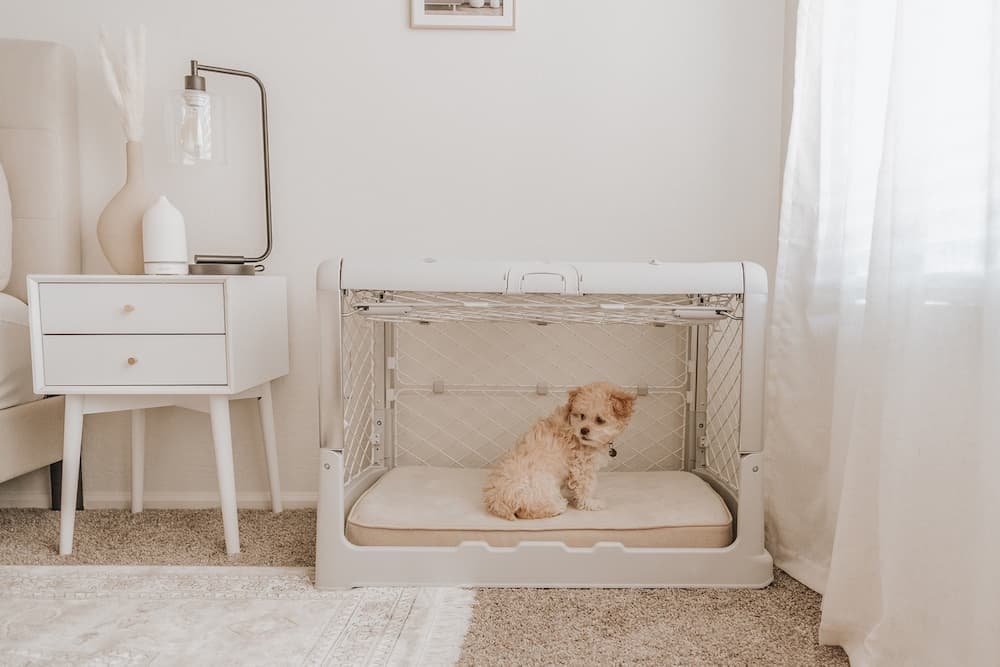Flying With a Dog: Rules, Safety, and Airline Information

If you love to travel but hate leaving your pooch behind, you should familiarize yourself with rules, regulations, and safety advice for flying with a dog on a plane. After all, no one wants the nightmare of ending up stranded at the airport because your airline won’t let you get on board with your pup.
To prevent such a scenario, we’ve gathered information on the best dog breeds for flying, airlines that have pet policies, and essential travel advice to keep your dog comfortable and safe while in the air.
Can I Bring My Dog on a Plane?
Different airlines have their own pet policies related to bringing your dog on an aircraft. Whether you can bring your dog onto the plane in the cabin largely depends on your dog’s size and weight. Exceptions may be made if you are traveling with a service dog or an emotional support dog.
Here is some general information that will help you understand whether you can bring your dog on your flight.
Size, Weight, and Age Are Key Factors
Most airlines will allow dogs that weigh below 20 pounds in the plane’s cabin as long as the dog is secured in a carrier at all times during the flight and is not a disturbance to fellow passengers. If a dog is larger than 20 pounds, the airline may require your dog to fly in the plane’s cargo hold. Weight restrictions vary by carrier, so make sure to double check with your airline before booking a ticket.
The United States Department of Agriculture (USDA), which regulates air transportation of pets, also requires that dogs be at least 8 weeks old to fly on a plane and fully weaned from their mother. Individual airlines may have their own rules regarding your dog’s age. Transporting puppies younger than 12 weeks is not recommended, since young puppies will not have all of their vaccines and are more likely to get sick than older dogs.
You Will Need an Airplane-Friendly Dog Carrier
In order to bring your dog on a plane, you’ll need to secure them in an airplane-friendly pet carrier that can fit underneath the seat in front of you. Keep in mind that this carrier will need to go through security at the airport, so you should be able to easily get your dog in and out of the carrier as needed. A dog carrier for flying should be well ventilated, lightweight, and secure enough to contain your dog while in transit.
Your Dog Needs an Up-to-Date Rabies Vaccine
Some airlines will ask for proof of vaccinations or health certificates from your veterinarian in order for your dog to be able to fly on a plane. While vaccine and health requirements may differ by airline, all airlines operating in the U.S. do require an up-to-date rabies vaccination.
Flying With a Dog in the Cabin Area

As previously mentioned, dogs under 20 pounds are welcome in the cabin area on most airlines. For this reason, some of the best breeds to fly on a plane with include:
- Chihuahua
- Yorkshire terrier
- Toy Poodle
- Maltese
- Brussels griffon
- Japanese chin
- Pomeranian
- Pekingese
- Bichon Frise
If you are bringing your dog on as a carry-on, you will be expected to place your pup in a secure carrier underneath the seat in front of you.
Pet fees apply on almost all flights. Cabin fees tend to be less expensive than fees for dogs being transported in the cargo area of the plane.
Can I Buy a Seat for My Dog?
Many airlines will allow you to buy a seat for your dog on a plane at the standard purchase price. This allows bigger dogs to have more room and for your dog to be up at your level for easy access during the flight. If the thought of having your dog at your feet makes you anxious or you want more space to spread out with your pup, buying your dog their own seat may make sense if you can afford it.
Dogs Flying In Cargo: Is It Safe?

If you have a dog who weighs more than 20 pounds, they may have to travel in the cargo hold of the plane. When your dog is in the cargo hold, you won’t be able to see them during the flight. However, not all airlines offer this option as the cargo deck needs to be pressurized to allow for pet travel.
Some airlines—such as JetBlue and Southwest—no longer fly dogs as cargo and only allow small dogs in the cabin of their planes. Other airlines may not allow certain dog breeds—such as brachycephalic breeds like Pugs and French Bulldogs—to fly in the cargo area due to the difficulty they may have breathing in warm temperatures or stressful situations.
It is unquestionably safer to fly with your dog in the cabin than it is for your dog to fly in cargo. However, if you have a large dog that you need to fly with and cargo is the only option, keep the following tips in mind:
Be Aware of Temperature Fluctuations and Rules
The cargo hold area of the aircraft also has temperature fluctuations, which can be uncomfortable—and even dangerous—for your dog. This is why some airlines have capacity and weather restrictions for pets traveling as cargo.
Depending on the forecast and temperature of your destination, you may be required to show a letter from your veterinarian saying that it is safe for your dog to fly in the cargo area of the plane. If temperatures are below 20 degrees or above 90 degrees, your dog may not be allowed to fly as cargo—even if you present a letter from your vet.
Choose the Right Dog Crate for Cargo
To be allowed into the cargo hold, your dog needs to be in a crate that is large enough for them to stand, move, sit, and turn their head. The container should also have a secure metal door, and the roof shouldn’t have holes. The crate should also be made of a rigid material that will not bend under pressure and it should have carrying handles so airline workers do not need to reach their hands into the crate.
If your dog is traveling in the cargo area of a plane, make sure to mark the words “Live Animal” on the top and side of the crate.
Know Your Booking Windows
Most airlines will only allow you to book your dog via cargo ten days before your trip. To avoid any disappointment, get organized with your vet’s approval and advice and check with the airline beforehand.

Flying With Service and Emotional Support Dogs
The United States Department of Transportation (DOT) recently updated its Air Carrier Access Act (ACAA) as it pertains to air travel of service animals. The rules and requirements have changed, and all details can be found on the DOT’s official service animal page.
As of this writing, an emotional support animal is no longer considered to be a service animal. Airlines are required to treat psychiatric service animals the same as other service animals.
For specific details as to whether your service animal can fly on a particular airline, it is best to reach out to the airline for details in advance of booking a flight.
Frequently asked questions about the DOT’s service animal final rules can be viewed on their FAQ page.
Service Animal Definition
There are many “scammy” websites and fake certification programs online that promise to validate your dog as a service animal.
The best resource for understanding what qualifies an animal as a service animal is the Americans with Disabilities Act website from the United States government.
Be advised that emotional support, therapy, comfort, or companion animals are not considered service animals under the ADA.
Airlines That Allow Dogs
While most airlines operating in the U.S. and internationally allow dogs to fly, here are some of the top dog-friendly airlines and their policies for flying with dogs.
American Airlines
Dogs can fly on American Airline flights as carry-on luggage in the cabin if they are under 20 pounds. The cost is $125 for in-cabin dogs. Cargo pricing varies depending on your dog’s weight, size, and the flight. Read more about American Airlines’ pet travel policy.
Delta
Delta does not have a weight limit for dogs flying in the cabin with their pet parents, but the dog must be small enough to fit under the seat in front of you and secured in an appropriate carrier. Dogs must be at least 10 weeks of age for domestic flights. The cost is $95 each way for dogs flying in-cabin on Delta. Read more about Delta’s pet travel policy.
Southwest
While Southwest doesn’t offer cargo transportation for dogs on planes, they do allow small, vaccinated dogs to travel in the cabin for a $95 pet fee. Dogs must be in an airplane-friendly carrier and fit in the seat in front of you. Dogs are not allowed on international Southwest flights or on flights to Hawaii. Read up on Southwest’s pet travel policy.
United
Unlike some other airlines, United allows you to bring your dog in addition to your regular carry-on allowance for certain flights. Puppies must be at least 4 months old and fit comfortably in a carrier under the seat in front of you to be allowed to fly in the cabin. In-cabin fees for dogs on United are $125. United discontinued its PetSafe transport program for larger dogs. Learn more about United’s pet travel policy.
JetBlue
Dogs under 20 pounds are welcome to fly in-cabin on JetBlue domestic flights. There is a maximum of two pets per traveler and dogs must be secured in an appropriate carrier under the seat in front of you during your flight. JetBlue charges a $125 pet fee (each way) for dogs to travel. Learn more about JetBlue’s pet travel policy.
Frontier
Frontier airlines welcomes small dogs in the cabins on all domestic flights and on international flights to the Dominican Republic and Mexico. Maximum measurements for a dog carrier are 18″ length x 14″ width x 8″ height. Pet fees on Frontier are $99 per way per pet. Read more about Frontier’s pet policy here.
Dog Breeds Banned On Airlines

The majority of global airlines have a list of dog breeds who are banned from flying. Airlines also restrict dogs from flying in certain weather conditions and temperatures.
Notable dog breeds restricted from air travel include the shortened head dog breeds and the bully dog breeds.
Shortened Head or Brachycephalic Dog Breeds
Shortened head or brachycephalic dog breeds are dogs that have short noses and muzzles.
These breeds aren’t allowed to travel on many airlines because they are prone to breathing problems due to their short noses. Their respiratory issues often worsen if they fly at high altitudes, or in the cargo hold area where temperatures fluctuate.
Examples of such breeds include:
- Bulldog
- French Bulldog
- Cane Corso
- Chow Chow
- Tibetan Spaniel
- Pug
- Shih Tzu
- Boston Terriers
- Boxers
- Pekingese
- Lhasa Apsos
- Mastiffs
Bully Dog Breeds
Airline restrictions on bully dog breeds are often blamed on Breed Specific Legislation. This has seen many airlines ban breeds such as American Pit Bull Terrier and American Staffordshire Terrier from air travel.
However, airlines have also added dogs that resemble Pit Bull dog breeds to this list, and even dogs that are said to have strong jaws citing bite incidents as the reason behind their tightened restrictions.
These breeds may include:
- American Pit Bull Terrier
- Bull Terrier
- Bulldog
- American Staffordshire Terrier
- Rottweiler
- Bull Mastiff
- Cane Corso
- Chow Chow
- Dogue De Bordeaux
- Boxers
- Shar Pei
- Crosses between any of the above breeds
Other Regulations Related To Flying With a Dog

The below rules may also affect your pet travel plans as they concern dog breeds allowed and not allowed on certain airlines.
Registration Rules
Most airlines require that you call in advance and let them know that you will be traveling with your dog. Other airlines such as JetBlue Airlines have an online registration so you can reserve a reservation for your dog online. This is because most airlines only allow a limited number of dogs on each flight. However, if you are traveling with a service or emotional support dog, this rule doesn’t apply.
Fees
Part of the registration process requires that you pay a fee to travel with your pup. The costs vary with the airline, although most airlines will ask between $95 and $150 each way. This rule doesn’t apply to service animals. Cargo is more expensive than if you book your dog to travel in the cabin with you.
Paperwork
Although some airlines may not require you to show health records for your dog, it is essential to have them as a precaution. You should have your dog license, medical records, and be prepared to sign a behavior voucher if your dog will be traveling with you in the cabin.
You must also have your dog’s immunization record. You can always find out the exact paperwork your airline will need for your dog by checking the airline’s website before the trip.
International Travel
At one point, The Centers for Disease Control (CDC) blocked the import of both foreign dogs and those re-entering the United States after traveling abroad. According to the CDC’s official website, all dogs imported into the United States must be healthy on arrival.
A lot of the restrictions surround the risk of rabies entering the U.S. For the most current information, we suggest visiting the Traveling with Pets page on the CDC’s website.
Dog Sedation During Flights
According to the American Veterinary Medical Association (AVMA), in most cases, it is not recommended to sedate your dog during air travel. Always check with your veterinarian in advance of air travel. Should sedation or tranquilization be recommended, your veterinarian can discuss the type, dosage, and frequency.
Further, the AVMA notes that some airlines require a signed pet parent statement that your dog has not been sedated prior to flying.
Flying With a Dog FAQs
How much does it cost to fly with a dog?
Pet fees vary by airline, but typically range in the $95 to $125 range to carry on a pet in the cabin. Fees for pets traveling in the cargo holds of planes are typically more expensive and may depend on the weight and size of your dog as well as your destination.
Can I buy a plane ticket for my dog?
Many airlines will allow passengers to buy a plane ticket and seat for their dog. This allows you to have your dog in their carrier on the seat, rather than on the floor, under the seat in front of you. This can provide your dog with more comfort and space and could make traveling less stressful. Keep in mind that buying a seat for your dog on the plane is more expensive than paying pet fees.
Where do dogs go on a plane?
If you are bringing your dog into the cabin on the plane, they are expected to be in a secure carrier and tucked under the seat in front of you. If you purchase a separate seat and ticket for your dog, you will be allowed to keep your dog and carrier on the seat. Most airlines require carriers to be certain dimensions or that dogs be under 20 pounds to fly in the cabin. For airlines that do offer cargo transportation for larger canines, dogs will be put in the cargo area of the plane. The cargo area is located in the belly of the aircraft.
Can I take my dog to Mexico?
If you are flying from the U.S. many airlines will allow you to take your dog to nearby international destinations including Mexico and the Dominican Republic. However, all airlines have different pet policies when it comes to international travel and it’s important to check with your airline prior to booking your trip. It’s also important to stay up to date on COVID-19-related rules and regulations for traveling internationally with your pet.
How stressful is flying for dogs?
The level of stress that your dog experiences while flying will depend on your individual dog and his or her own personality and preferences. However, it’s important to keep in mind that flying can be very stressful for dogs—especially if they are not used to the experience. To ease stress, get your dog used to the carrier in advance, bring familiar items like toys and blankets from home, and try to keep flights as short as possible. There are also over-the-counter calming aids that may help soothe panicked pups, such as ThunderWunder Calming Chews or Adaptil Spray. You can also ask your veterinarian about ways to de-stress your dog when traveling. Depending on your dog’s stress level, your vet may prescribe a sedative like Gabapentin or an anti-anxiety med like Trazodone Hydrochloride. If your dog is extremely anxious in crowds or new situations, it’s best to avoid flying unless it’s absolutely necessary.
Can you fly with a puppy?
Per USDA requirements, puppies need to be at least 8 weeks old in order to travel on a plane. However, many airlines do not allow puppies under 12 or 16 weeks to fly due to typical rabies vaccination schedules. Contact your airline before booking to ask about their minimum age requirement for puppies.









